Original | Odaily Planet Daily (@OdailyChina)
Author | Nan Zhi (@AssassinMalvo)_

Since Bitcoin broke through the new high of $69,000 three years ago, it has been oscillating widely between $50,000 and $70,000 for several months. After the Bitcoin halving, the foreseeable grand narrative is only the rate cut by the Federal Reserve.
And this event date is already set in stone. According to CME's Federal Reserve observation data, the probability of a rate cut by the Federal Reserve on September 24 has risen to 100%, with only a 25 basis point or 50 basis point difference, and the current probability of the two is about fifty-fifty.
So, can the rate cut bring a big market rally to Bitcoin and the entire cryptocurrency market? Odaily in this article reviews the five major rate cut cycles of the Federal Reserve from 1989 to 2019, exploring whether there is an objective rule.
The period from 2018 to 2020
The current round of Federal Reserve rate hikes ended on December 19, 2018, and the first rate cut began on July 31, 2019, three quarters later. This round of rate cuts is also the first and only rate cut cycle that Bitcoin and the cryptocurrency market have experienced. The trends of Bitcoin price, Nasdaq index, and gold price are as shown in the following figure:
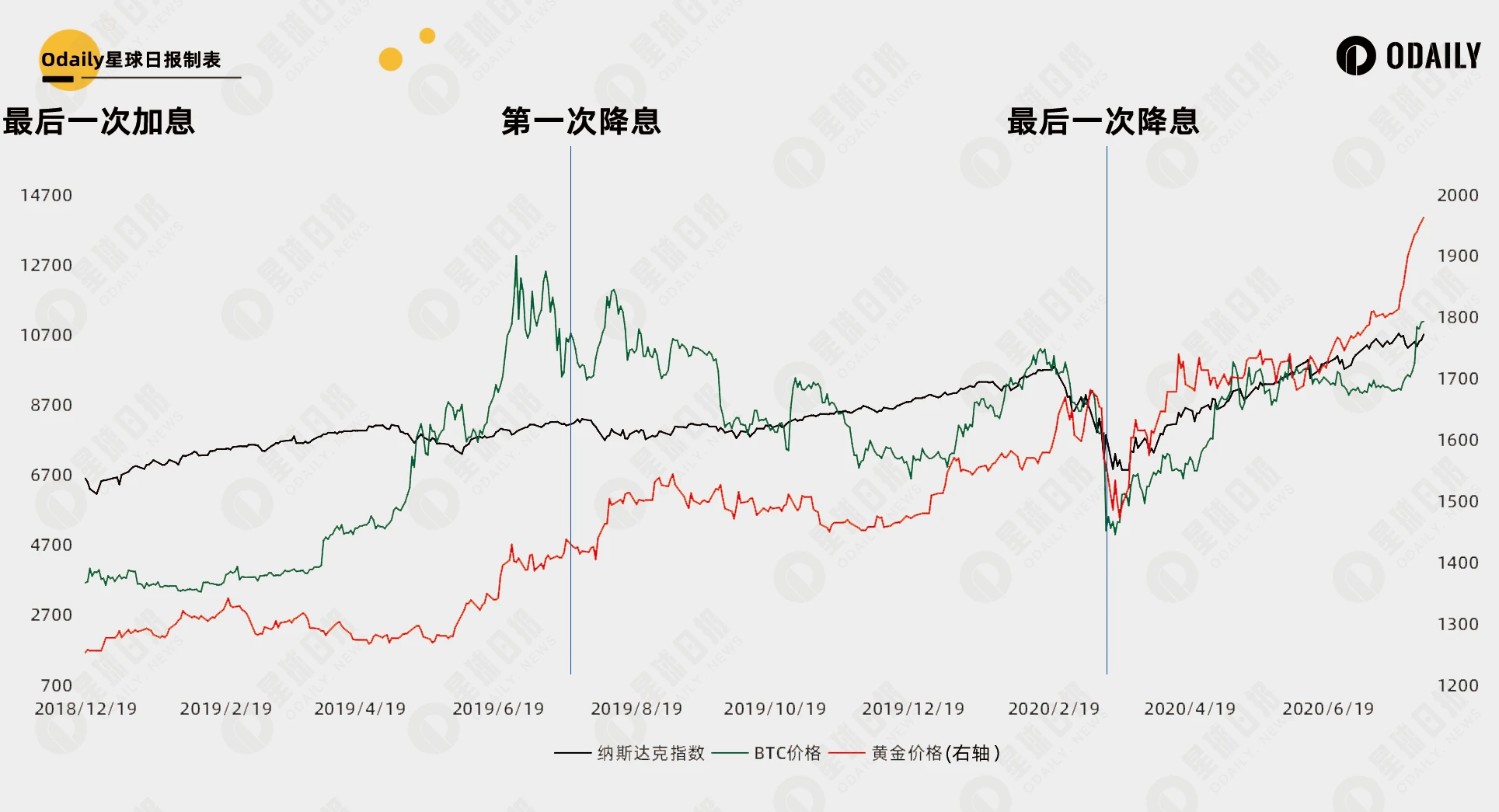
From the figure, it is obvious that the rate cut was already Price In before it occurred, especially Bitcoin had the largest advance. From the last rate hike to the first rate cut, Bitcoin rose by 161.7%, Nasdaq rose by 23.2%, and gold rose by 13.7%. After the rate cut, only Nasdaq and gold continued to rise, while Bitcoin continued to oscillate widely.
Before the last rate cut (March 15, 2020), Bitcoin experienced the well-known major plunge on March 12, and the global market was equally devastated. But at that time, the Federal Reserve had already lowered interest rates to 0.00%-0.25%, so it adopted a super-large-scale quantitative easing policy, which ultimately overflowed into the cryptocurrency market, triggering the bull market in 2021.
The comparison of the trends of the three major markets after the last rate hike on July 27, 2023 is as follows. At that time, just like now, from the last rate hike to August 2 (so the gold data is collected up to this day), Bitcoin rose by 122.6%, Nasdaq rose by 19.4%, and gold rose by 27%. Bitcoin may have once again Price In for the rate hike.
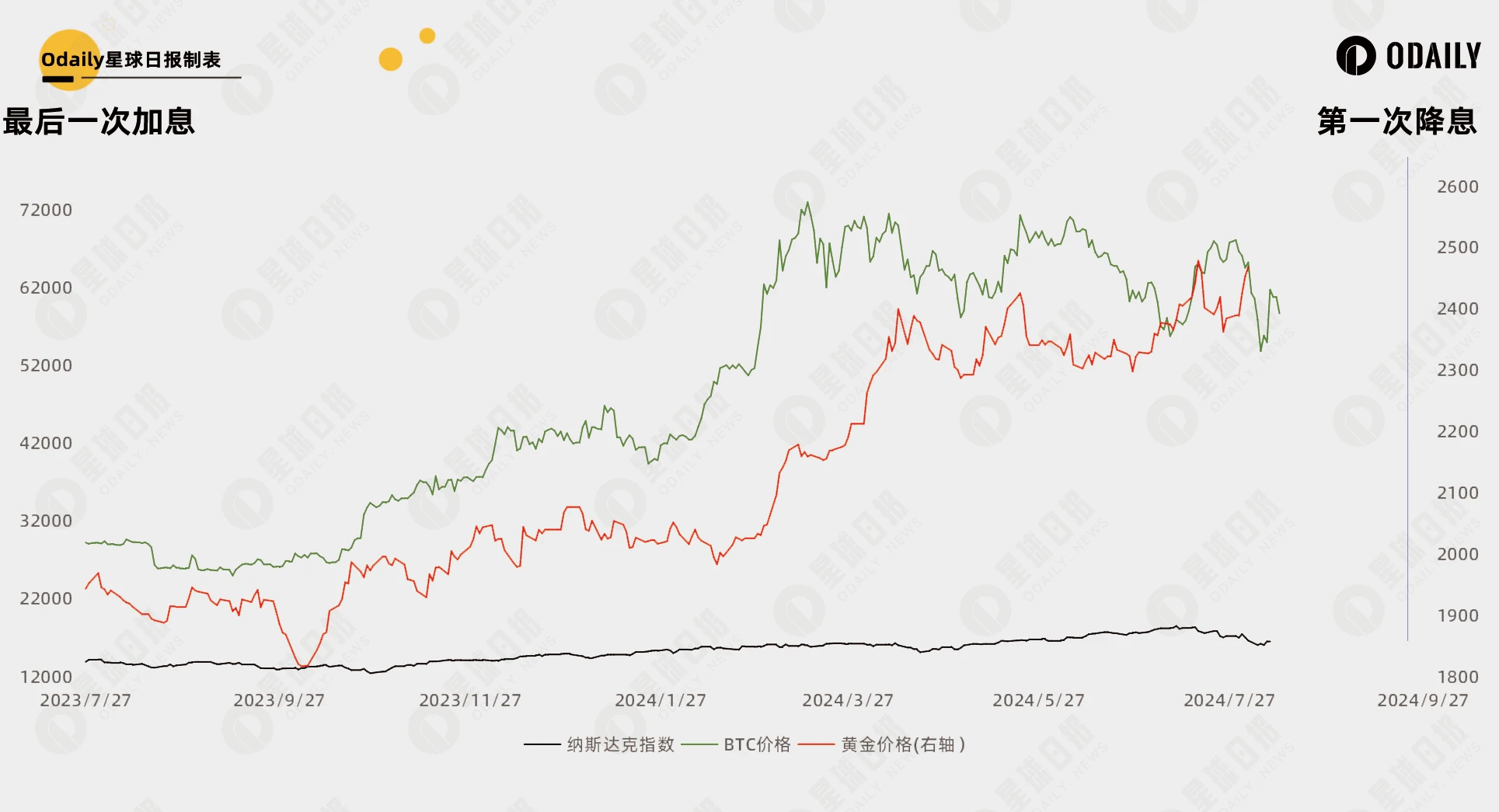
Looking back at 1989-2008
To go further back, we need to look at the rate cut cycles in the United States since 2007, when Bitcoin had not yet been born. But it is generally believed that the cryptocurrency market still has a strong correlation with the US stock market, so we still use the trends of the Nasdaq and gold prices as the research objects and substitutes for the Bitcoin price to explore the fluctuation relationship between the rate cut and prices.
2006 - Hard Landing
In the cycle starting from 2006:
The last rate hike occurred on June 29, 2006, and the federal funds rate rose to 5.25%.
The first rate cut occurred on September 18, 2007, and the federal funds rate was lowered from 5.25% to 4.75%.
The last rate cut occurred on December 16, 2008, and the federal funds rate fell to 0% to 0.25%.
In terms of trends:
The Nasdaq rose before the rate cut, fell after the rate cut, and rose before and after the rate cut ended;
Gold rose before the rate cut, oscillated and rose after the rate cut.
In terms of the historical background:
The subprime mortgage crisis broke out in 2007, the financial system collapsed, and the Federal Reserve began to cut interest rates in September to cope with the deteriorating financial situation and the threat of economic slowdown, and then Bitcoin was born.
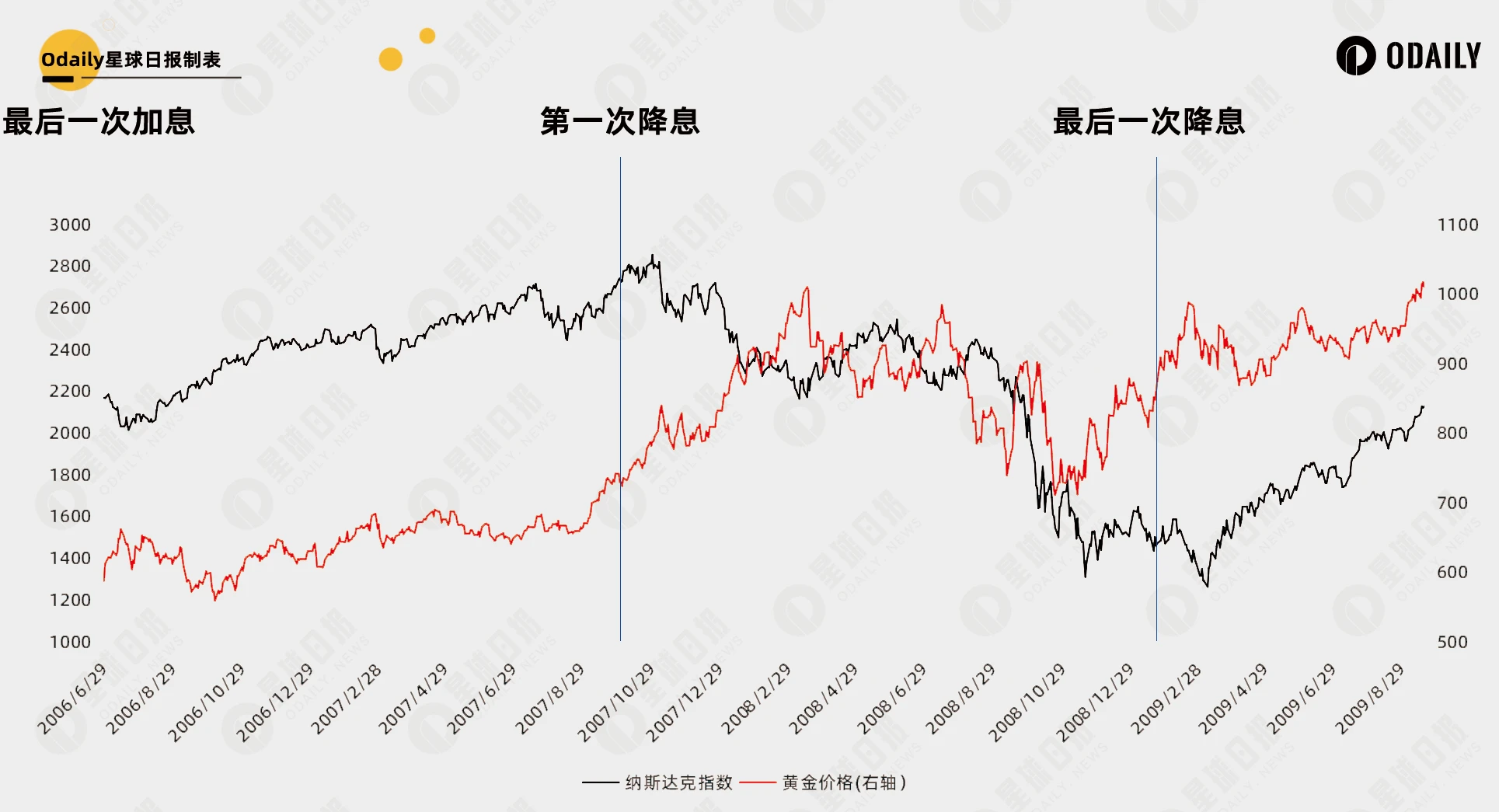
2000 - Hard Landing
In the cycle starting from 2000:
The last rate hike occurred on May 16, 2000, and the federal funds rate rose to 6.50%.
The first rate cut occurred on January 3, 2001, and the federal funds rate was lowered from 6.50% to 6.00%.
The last rate cut occurred on June 25, 2003, and the federal funds rate fell to 1.00%.
In terms of trends:
The Nasdaq rose before the rate cut, fell after the rate cut, and rose before and after the rate cut ended (the first peak was seen in June 2004, not shown in the figure);
Gold rose before the rate cut, oscillated and rose after the rate cut.
In terms of the historical background:
The bursting of the Internet bubble in 2000, and the sharp decline in the valuations of technology stocks and Internet companies. The Federal Reserve began a series of rate cuts in early 2001 in an attempt to alleviate the pressure of the economic recession. However, due to the market collapse caused by the bursting of the bubble and the significant decline in corporate profits, the market sentiment was extremely pessimistic.
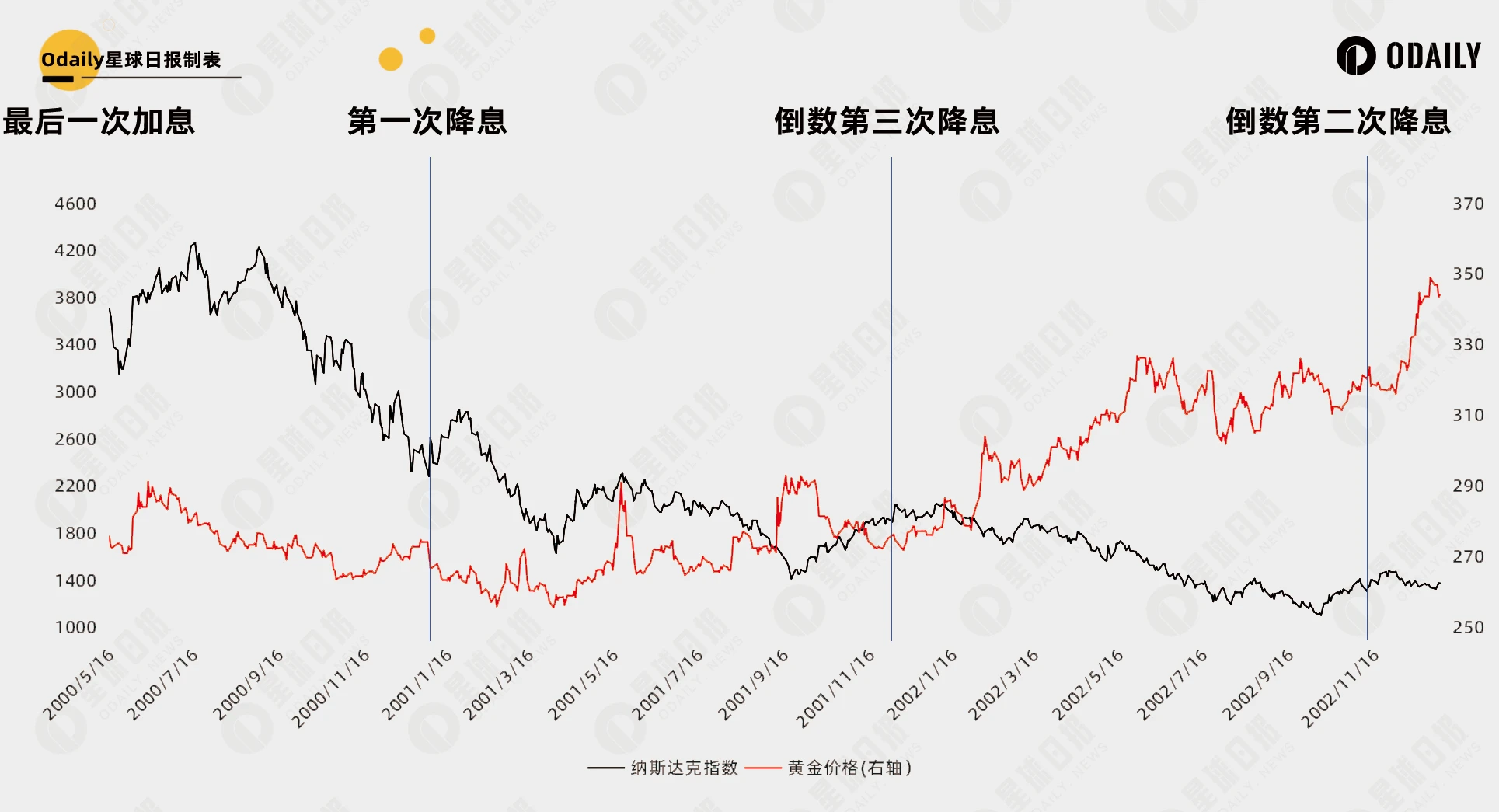
1995 - Soft Landing
In the cycle starting from 1995:
The last rate hike was completed on February 1, 1995, and the first rate cut began on July 6 of the same year, with the last rate cut on December 19. The entire cycle was very short compared to other years.
In terms of trends:
The Nasdaq rose before the rate cut, and rose after the rate cut;
Gold oscillated before the rate cut, and fell after the rate cut.
In terms of the historical background:
At that time, the US economy was relatively strong and was in the early stages of technological innovation and Internet development. The rate cut in 1995 was a preventive measure aimed at supporting the continued expansion of the economy, so it was also very short-lived.
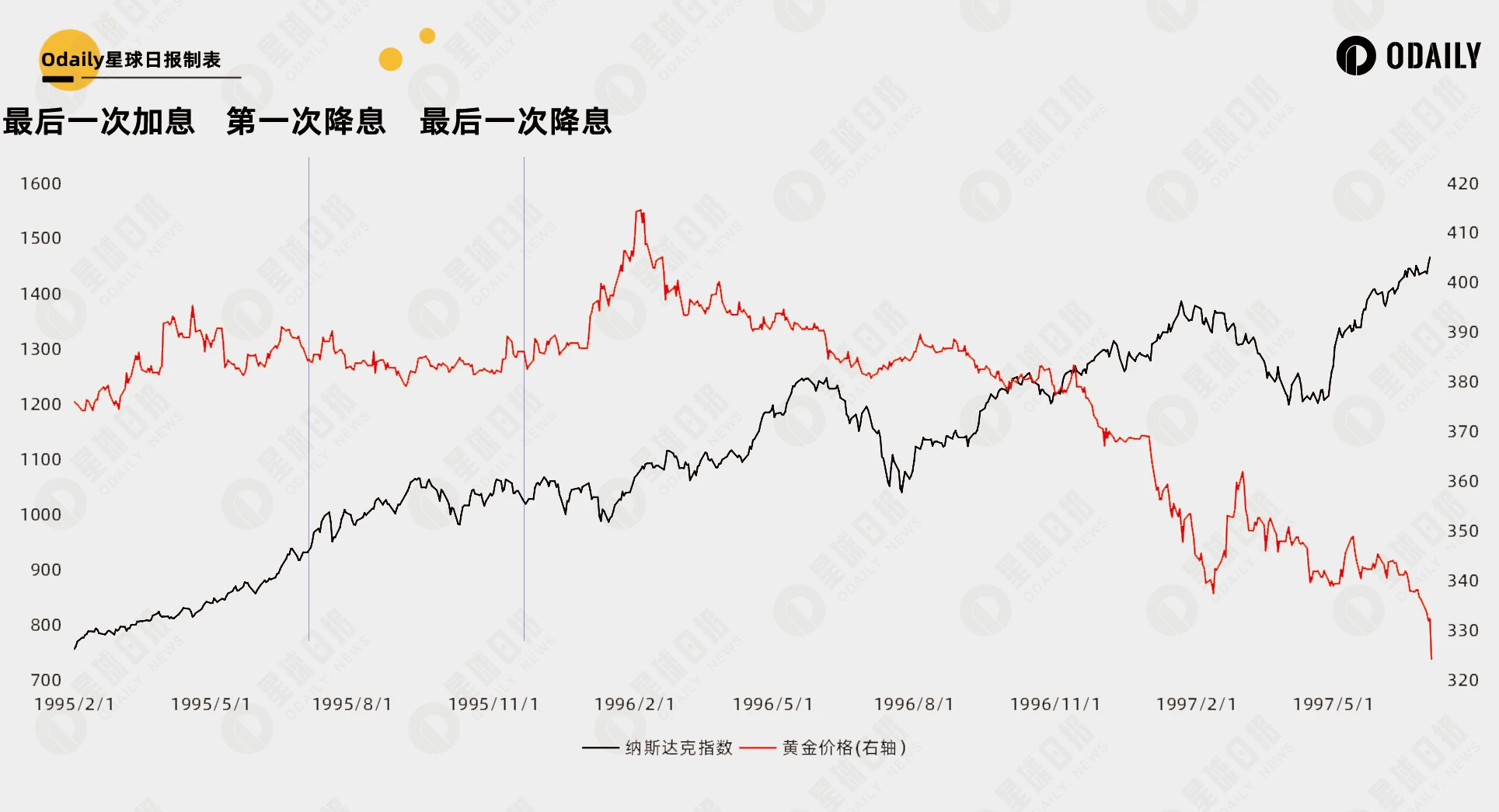
1989 - Soft Landing
In the cycle starting from 1989:
The last rate hike: February 24, 1989, the federal funds rate rose to 9.75%.
The first rate cut: June 28, 1989, the federal funds rate was lowered from 9.75% to 9.5%.
The last rate cut: September 4, 1992, the federal funds rate fell to 3.00%.
In terms of trends:
The Nasdaq rose before the rate cut, oscillated after the rate cut;
Gold fell before the rate cut, and oscillated after the rate cut.
In terms of the historical background:
In the 1980s, the US economy experienced a relatively long period of expansion. By 1989, the economic expansion had lasted for 7 years, becoming one of the longest economic expansions since the post-war period. By the end of the 1980s, the United States faced high inflationary pressures, and the Federal Reserve responded to inflation by raising interest rates in 1988. However, these rate hikes showed a suppressive effect on economic growth in 1989.
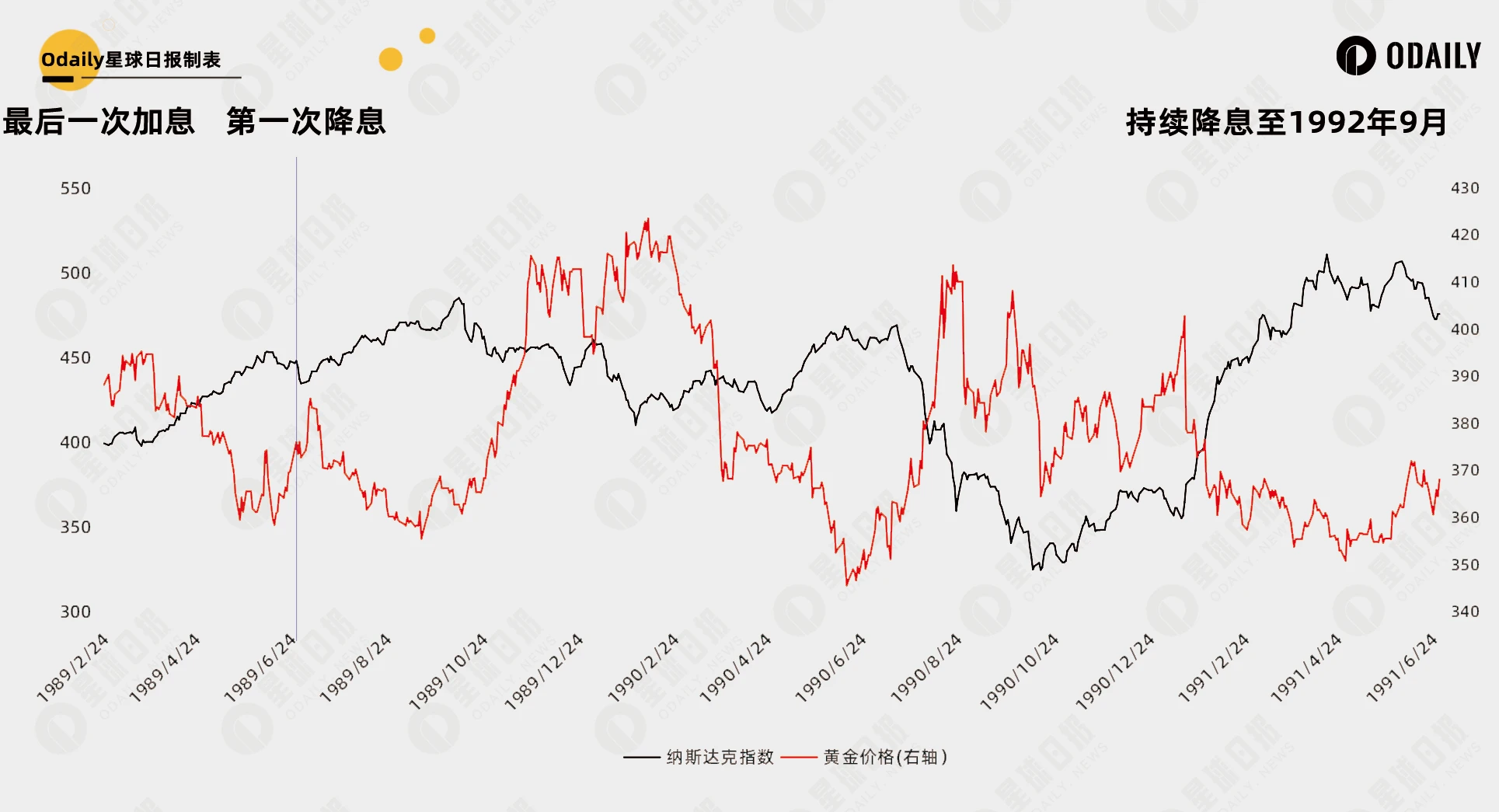
Conclusion
In summary, there are several significant conclusions:
The rate cut will not directly start a bull market in the stock market and major asset classes, and the related impact often has already been Price In;
The impact of the rate cut on the future market depends on the overall economic situation at that time, whether the rate cut is to promote economic development proactively, or whether it is forced to cut rates due to a black swan event. From the perspective of the US stock market, it is a struggle between economic resilience and loose liquidity pricing.
Gold generally benefits from the decline in interest rates (while the US dollar falls) and mostly rises, with better performance in a hard landing mode.
Therefore, from the perspective of historical rules, the rate cut is unlikely to be the fundamental driving force for the rise of Bitcoin and the cryptocurrency market. Since 2024, we have experienced events such as the Bitcoin spot ETF and halving, and the market needs the next grand narrative or fundamental change.
免责声明:本文章仅代表作者个人观点,不代表本平台的立场和观点。本文章仅供信息分享,不构成对任何人的任何投资建议。用户与作者之间的任何争议,与本平台无关。如网页中刊载的文章或图片涉及侵权,请提供相关的权利证明和身份证明发送邮件到support@aicoin.com,本平台相关工作人员将会进行核查。




